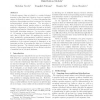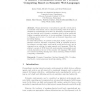252 search results - page 8 / 51 » Using OWL to model biological knowledge |
SDM
2003
SIAM
13 years 8 months ago
2003
SIAM
A labeled sequence data set related to a certain biological property is often biased and, therefore, does not completely capture its diversity in nature. To reduce this sampling b...
SEKE
2005
Springer
14 years 1 months ago
2005
Springer
Checking for properties of Web ontologies is important for the development of reliable Semantic Web systems. Software specification and verification tools can be used to complem...
NLDB
2004
Springer
14 years 26 days ago
2004
Springer
Human interaction occurs always in a specific context and in a particular environment, and a common knowledge base about them is essential for understanding each other. By immersi...
IESA
2007
13 years 9 months ago
2007
Domain ontology building is one of the most critical activities required in Semantic Web applications. The task must be performed by domain experts, who do not (generally) have the...
BMCBI
2008
13 years 7 months ago
2008
Background: Predictive classification on the base of gene expression profiles appeared recently as an attractive strategy for identifying the biological functions of genes. Gene O...


